Last week, Flytrippers was invited to a special Aeroplan presentation at their Toronto offices. Since it was in person, I suspected it was something very major (and I therefore cut a week from my current 6-continent trip)! And indeed, Vice-President Scott O’Leary explained the biggest Aeroplan changes since the program’s complete overhaul in 2020!!!
Fortunately, it doesn’t affect the redemption (burning) side of the program at all; the program’s strength, which makes it the best in Canada, and by far. Points redemptions for unlimited value (guaranteed fixed prices on partner airlines) don’t change in any way. Nothing at all is affected on that side.
The changes are related to the accumulation (earning) side of the program; both earning points and earning the elite status qualification instrument (2 separate things that too many people confuse). And also to elite benefits, though that’s less drastic, while everything changes completely for the earning.
Here are all the details of the Aeroplan changes now been made public (there had been leaks about this for weeks now).
Overview of Aeroplan changes
The changes are n0t even strictly negative. That’s surprising, as you know if you follow this field; many airlines constantly devalue their program! Air Canada deserves credit for how they want to create value with Aeroplan and how they see it as a powerful lever. Their VP is actually a points addict like all of us!!!
It’s therefore important to note that he confirmed the changes are made at neutral cost for Air Canada. They won’t invest less money in the rewards program, but rather better invest the money in question.
Optimize! That means rewarding the most active members better with points and elite benefits (and conversely, rewarding the others less, obviously). And better incentivizing to spend more with them. It’s obviously very legitimate and logical; it makes sense, rationally. They have to pay the flight attendants who voted 99.7% for a strike mandate this week! 😅
Here’s what changes:
- Aeroplan points earning
- Aeroplan elite status qualification instrument earning
- Aeroplan elite status benefits
Here’s what doesn’t change at Aeroplan:
- Everything else
There are heaps of details, of course, with such a major change.
So I’ll explain and synthesize them below according to the 3 changes to keep it organized and clear, even if it’s hefty. And we will have more content to come soon.
Here’s when the Aeroplan changes take effect:
- January 1st, 2026
- So for the 2027 status qualification
- Nothing changes to the current qualification for 2026
The 2 earning aspects are what change most drastically.
The program switches to what’s called the revenue-based accumulation model in rewards jargon, meaning based on spending. Credible rumors had leaked about this in July on the Internet, so when I got the Aeroplan invitation a few weeks ago, I obviously understood it must be true.
Basically, revenue-based means that earning is based on the amount spent and not the distance traveled (the current model, which has been in place for decades and is quite unique to airlines). It’s very common by the way; several airline programs have switched to revenue-based in recent years.
It will obviously reward some travelers better, while others will earn less. In terms of elite status specifically, it also means that spending on credit cards is now more helpful. And also that, without even flying, contrary to now, you can get more than just the entry-level Aeroplan 25K status.
Let’s look at each of the 3 changes. For each, we have an overview, a brief analysis of what the change represents, and the details.
Aeroplan change 1: Points earning
This is what affects all members, obviously, because everyone can (and should) earn Aeroplan points via the rewards program directly (even though this is not the fastest way).
Here are the basics of Aeroplan’s changes to points earning:
- Revenue-based earnings (based on amount spent)
- Goodbye to the distance flown
- It’s really very logical
- Base earn rate for all and elite member bonus
- 1 point per 1 CAD spent (≈ 1,5%)
- 2X to 6X more points earned (≈ 3% to ≈ 9%)
- Taxes obviously excluded from the amount spent
- Only affects earnings on certain flights and packages
- Flights operated or sold by Air Canada and Air Canada Vacations packages
- Not flights operated by a partner sold by the partner directly
- Not earnings on all things other than flights
- Only affects earnings via the program directly
- Not earnings via Aeroplan cards
- Cards are always the best way to earn (the most basic thing)
- New compelling promotions for more earnings on flights for everyone
- Like 5X more points earned on specific flights (≈ 7.5%)
- Stackable with the elite bonus (≈ 10.5% to ≈ 16.5%)
- Extremely promising for deal lovers (depending on the details)
- New earn rates that reward elite members a lot more
- Elite bonus now also available on 6 special partner airlines
- A logical choice to make elite status more valuable

We’ll look at all 6 aspects after a brief analysis.
Analysis of the Aeroplan points earning changes
It’s therefore a major change in theory, but in practice, the amount of points earned doesn’t change enormously for the vast majority of flights (flights at “normal” prices, economy class flights, tickets in the lowest fare classes, short-distance and medium-distance flights, members who don’t have elite status).
And since it’s already so slow to earn this way anyway, the impact is truly minimal for most. This is what we saw in calculating dozens of concrete examples this week since we got the information, but we’ll calculate even more and do a detailed comparison post soon.
It could therefore even be positive because short-distance flights often end up earning more (and many people travel short distances) and because savvy travelers might well benefit from the new concept of promotions on points accumulation!!!
Revenue-based earnings
The concept is very simple: the more you spend, the more you earn. It’s quite logical. In all industries other than aviation, it’s obviously almost always like that with rewards programs.
Distance-based earning was quite unique. The airline doesn’t get anything from you going further. They get something from you spending more.
Air Canada spends an amount on their rewards program, so they logically want to use that amount to incentivize what brings them money. Wouldn’t you do the same if you had a business?
It’s also much simpler for the average traveler to know how many points they’ll get for a flight:
- Now:
- Calculate the distance traveled
- Find your fare class
- Find the earn rate of the fare class
- Multiply the distance by the earn rate
- That’s the number of points earned
- In 2026:
- Read the pre-tax price on your confirmation email
- That’s the number of points earned (or add the multiple if there’s a promotion or if you have elite status)
Earn rate on Air Canada and partner airlines
The earnings are simple for flights operated by Air Canada (whether sold by Air Canada or a partner) and for flights operated by a partner sold by Air Canada.
You get 1 point per 1 CAD spent (≈ 1.5%). And you get a bonus with the multiplier if you have elite status (explained below). As always, this is in addition to the new promotions and in addition to what you obviously earn on your credit card.
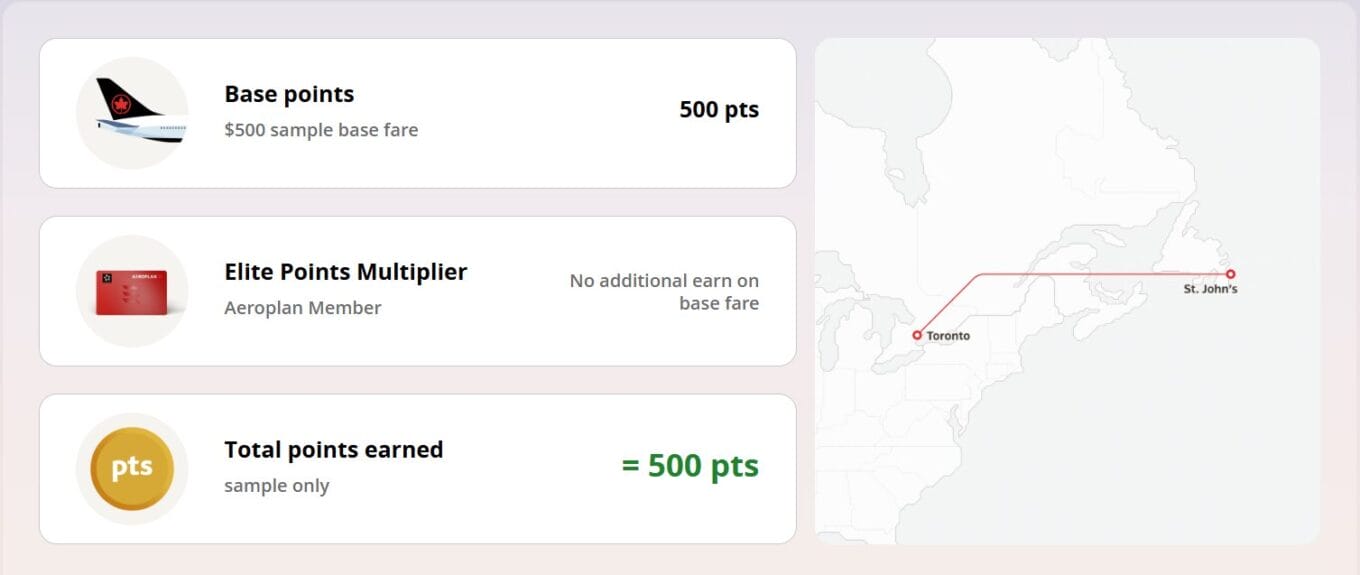
Nothing changes for partner flights sold by partners. For them, earning is still distance-based, so based on distance traveled and booking class (the fare classes are divided into booking classes; that’s all you need to know).
This means there could be many more potential arbitrage opportunities by booking a flight on partner airline websites directly and earning points based on distance flown (however, the specific arbitrage opportunities change because of these Aeroplan changes).
But I’ll save that for a separate post soon to lighten this here. Keep in mind that such arbitrage affects your elite status qualifying instrument earnings (change #2 below).
It wouldn’t be a rewards program feature if there weren’t a small exception and complexity (only for members who have elite status)!
The new earning system introduces a new partner classification, but it’s to our advantage! To be clear, this is only if the ticket is sold by Air Canada (this complexity doesn’t exist for flights operated by a partner sold by a partner directly).
Earnings will be exactly the same for joint venture (JV) partners as on Air Canada. The JV partners are United, Copa, Lufthansa, SWISS, Austrian, and Brussels. So you’ll obtain the elite bonus of up to 6X! It might seem strange to add an incentive to take an airline other than Air Canada, but a joint venture precisely means the airlines share profits.
However, on the other partners (non-JV), all travelers will earn only 1 point per 1 CAD spent (≈ 1.5%), with no elite bonus.
This new special partner classification is honestly the only thing that worries me a bit, even if it’s far from certain and there’s no indication it’s coming, according to the Vice-President: the other JV partners could eventually join United, the few other special partners, and Air Canada with dynamic pricing for points redemption for more seat availability.
Maybe not, but the very creation of this distinction makes me think of the worst, because other airlines have gotten us used to it (even if Aeroplan has been very good for 5 years). To be continued!
Here’s the simplified version of the points earned by airline if the ticket is sold by Air Canada:
- Flights operated by Air Canada
- Earnings based on the amount spent
- Elite bonus
- Promotions
- Flight operated by JV partners
- Earnings based on the amount spent
- Elite bonus
- Flight operated by non-JV partners
- Earnings based on the amount spent
- No elite bonus
Here’s the simplified version of the points earned by airline if the ticket is sold by a partner airline:
- Flight operated by Air Canada
- Earnings based on the amount spent
- Elite bonus
- No promotions
- Flight operated by partners (NO CHANGE)
- Earnings based on distance and booking class
- No elite bonus
The earnings also change for packages that include an Air Canada flight. I don’t know anything about this, but God knows how much Canadians love their packages!
So I’m just giving you the basics, and I’ll analyze the change in more detail and come back to it soon.
Here’s the new earn table for packages:
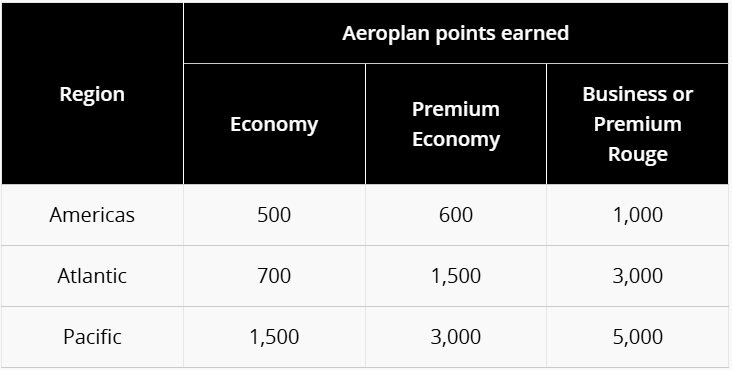
No change to other earning methods
Nothing else changes. Aeroplan credit cards allow you to earn additional points. It’s always on top of the earn via the program directly. In fact, cards will even now be able to help achieve elite status too; but that’s change #2 below.
The basics of earning rewards are to always earn at least in those 2 ways (even 3 ways with many programs, including Aeroplan).
The 3rd way is with the Aeroplan eStore. Nothing changes there, nor for earnings on anything that’s not a flight with the Aeroplan program directly (hotels, car rentals, Journie gas stations, Uber, Uber Eats, Starbucks, LCBO, etc.)!
New promotions
Those who like deals could be big winners in terms of earnings!
We obviously know very little, but it’s really very promising that compelling promotions now exist for earning points on flights. Air Canada does a very good job with varied promotions related to rewards, so we can expect interesting things.
As with everything in the travel world (or in life), those who are savvy and who take advantage of deals save so much money. This will now apply even more to Air Canada flights booked in cash, thanks to more points earned!
The Vice-President insisted on the fact that this model will allow offering more aggressive promotions like 5X points on flights to Europe, to give the example he used. Not just something pretty lame like 2X points.
I assure you, I tried to ask him for more examples (it even made the team laugh), but he said he wanted to stop there for now.
New structure that rewards elite members
Finally, the idea is also to better reward the best customers, those who have elite status.
It’s a strategic choice. One that is logical. It’s unfortunate for most people, who don’t have status (airline status is much harder to achieve than hotel status that is so easy).
But elite travelers are so much more profitable for an airline, so rationally, I completely understand the idea of rewarding them more and making sure it’s even more valuable to have status.
Here’s concretely how many Aeroplan points you’ll earn on Air Canada in 2026 according to your status:
- Non-elite member
- 1 point per 1 CAD spent (≈ 1.5%)
- 25K elite member
- 2 points per 1 CAD spent (≈ 3%)
- 35K elite member
- 3 points per 1 CAD spent (≈ 4.5%)
- 50K elite member
- 4 points per 1 CAD spent (≈ 6%)
- 75K elite member
- 5 points per 1 CAD spent (≈ 7.5%)
- Super Elite member
- 6 points per 1 CAD spent (≈ 9%)

Aeroplan change 2: Elite status qualification instrument earning
This interests those who value elite status and all the benefits that come with it, and it’s what changes the most drastically, and by far.
Here are the basics of the Aeroplan changes for the status qualification instrument earning:
- Purely revenue-based earnings (based on the amount spent)
- And not just on the amount spent on flights
- Precise earn rates listed below
- Welcome to the new SQC
- Status Qualifying Credits
- Unique and simplified qualifying instrument
- Goodbye to current SQM, SQS, and SQD
- And to the complexity that resulted from them
- SQC earnable everywhere
- Plane tickets sold by Air Canada
- Plane tickets sold by Star Alliance partner airlines
- Everyday partners (Journie gas stations, Uber, Starbucks, etc.)
- Spending on premium and main-level Aeroplan cards
- But not on the Aeroplan eStore (unfortunately)
- Easier qualification for higher elite status without flying
- But not that useful if you don’t actually fly…
- New earn rates that reward higher classes much more
- Higher fare classes (very expensive)
- Higher seat classes (even more expensive)
- New benefit for requalification with premium cards in 2027
- 10% of SQC earned the previous year
- Automatically deposited to the account
- With special transition benefit for 2026
- No changes to 3 popular features
- 25K elite status with EDQ (still by points earned)
- Lifetime Million Mile status (still by distance flown)
- Banked Super Elite status (still there; now at 200,000 SQC)
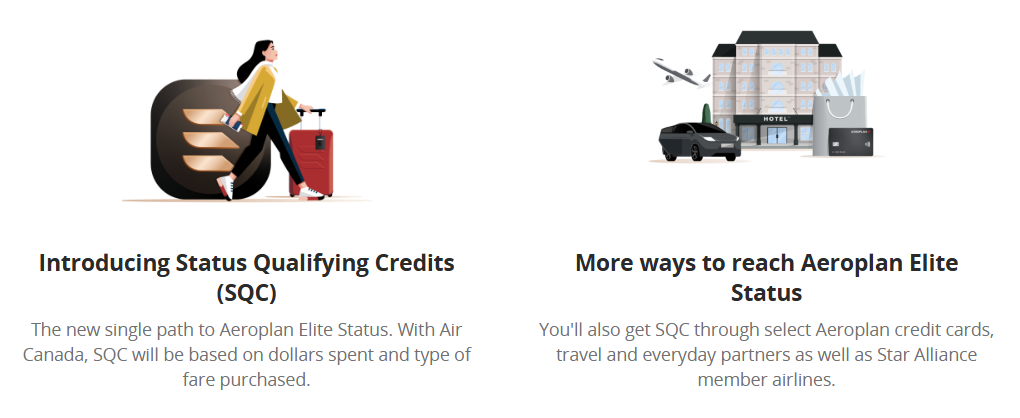
We’ll look at each of these 8 aspects after the brief analysis.
Analysis of the Aeroplan elite status qualifying instrument earning change
It’s big. But according to Air Canada’s objective data from previous years, the vast majority of people will be at equal or higher status with the new qualification system.
The change is therefore not aimed at reducing the number of elite members; the Vice-President said explicitly that they’re comfortable with current numbers (but the change will reduce lounge congestion nonetheless; which is definitely positive). The goal is to incentivize members to spend more, of course.
Including on Aeroplan credit cards. And with travel partners. And with everyday partners.
Being able to qualify for elite status in these ways is a big change; I’ll come back to this in the next section.
In terms of the impact of earning changes for flights, again, short-distance flights end up benefiting. Just like flights in higher seat classes and especially in higher fare classes. Here, too, I’ll share detailed examples soon.
Finally, maybe you’re wondering how the changes will be able to help reduce congestion in Air Canada Maple Leaf airport lounges without reducing the number of members with 50K+ elite status?
Well, because of the changes, the cohort of travelers who will have 50K status will happen to travel less often than the cohort under the current system! If you travel less, you use lounges less.
By the way, I took the opportunity to ask several questions about upcoming lounge openings and renovations. I’ll share that in a separate post soon.
Elite status without flying
In case you don’t know, credit cards are extremely profitable for airlines.
(In the United States, the 3 legacy airlines each have about 1000 planes and lose money on their flights!!! But they still make billions in profit. How? Credit cards! It’s that crazy! The craziest statistic is that 1% of US GDP is charged on Delta Amex cards!!!)
Anyway, several airlines have changed their qualification to include credit card spending. Air Canada is doing the same thing, but in a very moderate fashion. There’s a cap associated with this qualification method. They continue to give great value to flights. It’s very reasonable.
So in theory, you’ll now be able to get 50K elite status without ever flying (25,000 SQC with partners and 25,000 SQC with credit cards), which is better than the 25K elite status that’s the highest level possible right now with the EDQ (I’ll come back to that below).
But in practice, it remains quite uninteresting for the majority. It’s that the opportunity cost of spending there rather than unlocking big welcome bonuses is ENORMOUS. For those who don’t travel much, more welcome bonuses is probably worth more than the value of elite status benefits.
To be clear, these elite benefits are amazing.
But if you don’t fly, you don’t benefit from them… So what’s the point? Get welcome bonuses instead to precisely travel more, for free!
It remains that it can be interesting to reach a higher elite level that you’re close to, if you don’t want to maximize your earned rewards at all (as is the case for so many travelers, sadly). Provided you’re also a very big spender, because you actually earn very little SQC from credit card spending.
Qualification thresholds with revenue-based earnings
Once again, like for points earning, it’s logical that it’s based on spend.
And again, it’s simplified in that there are no longer 2 separate thresholds to reach to get elite status (SQM/SQS AND SQD). There is only SQC. That’s it.
Currently, you must reach either the required SQM or SQS, plus the always required SQD. It’s really not that complicated, but many who are too busy/lazy to learn often find it too complex.
The new Aeroplan elite status qualifying instrument is called SQC; Status Qualifying Credit. It replaces the 3 existing instruments! The earning is a bit more complex, so I don’t know if it’s really that simplified overall.
Here’s how to qualify for Aeroplan elite status:
- 25K elite status
- 25,000 SQC
- 35K elite status
- 35,000 SQC
- 50K elite status
- 50,000 SQC
- 75K elite status
- 75,000 SQC
- Super Elite status
- 125,000 SQC
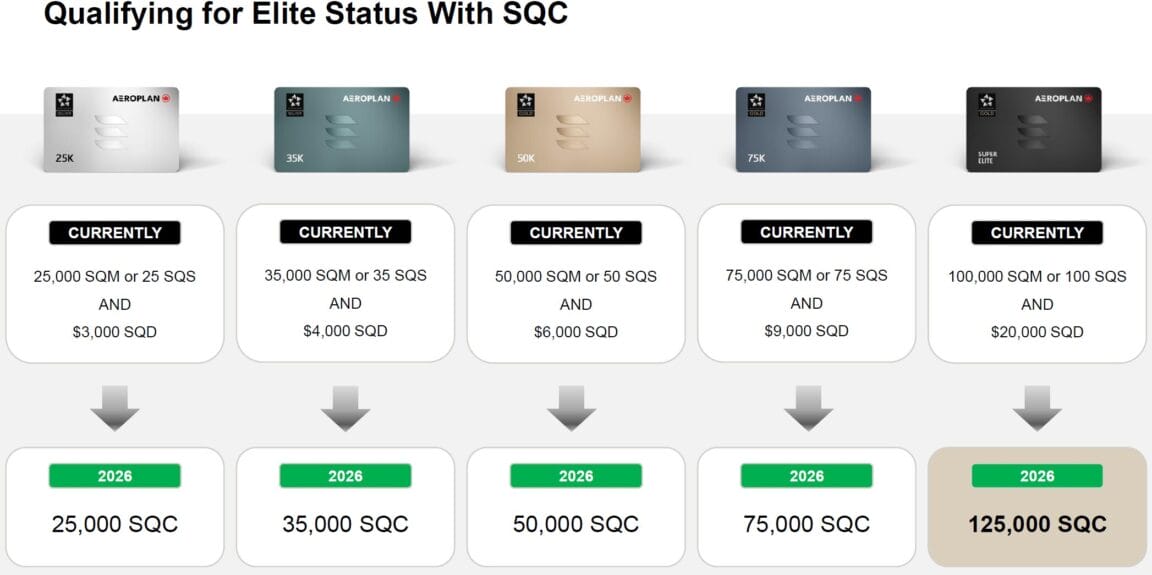
The thresholds, therefore, remain faithful to existing nomenclature; the “only” change is 125,000 SQC for Super Elite instead of 100,000 SQM (which won’t affect many travelers according to their data).
Here are the 3 main ways to earn SQC in 2026:
- Spending with Air Canada (flights and packages)
- No annual SQC cap this way
- Spending with partners (flights and other)
- 25,000 SQC annual cap this way
- Spending on Aeroplan credit cards
- 25,000 SQC annual cap this way
I’ll detail the 3 separately below, but let’s also look at it by airline and ticket issuer.
Here’s the simplified version of SQC earnings by airline if the ticket is sold by Air Canada:
- Flight operated by Air Canada
- Earning based on fare class
- Flight operated by Star Alliance partners
- Earning based on fare class
- Flight operated by non-Star Alliance partners
- 0 SQC
Here’s the simplified version of SQC earnings by airline if the ticket is sold by a partner airline:
- Flight operated by Air Canada
- Earning based on seat class
- Flight operated by Star Alliance partners
- 1 SQC per 5 Aeroplan points earned (25,000 SQC cap)
- Flight operated by non-Star Alliance partners
- 0 SQC
SQC earnings with Air Canada spending
With Air Canada means sold by Air Canada (no matter who operates the flight).
Here are the SQC earn rates on flights operated by Air Canada and Air Canada Vacations packages:
- Basic Economy fare class flight
- 0 SQC
- Standard Economy fare class flight
- 2 SQC per 1 CAD spent
- Flex Economy and above fare class flight
- 4 SQC per 1 CAD spent
- eUpgrades add-ons
- 2 SQC per 1 CAD spent
- Packages
- 1 SQC per 1 CAD spent
- Taxes and fees exceptionally included here
- Because the earn rate is lower anyway
- To keep it simple (people who like things simple precisely love packages)

Here are the SQC earn rates on flights operated by Star Alliance airline partners:
- Basic Economy fare class flight
- 0 SQC
- Standard Economy fare class flight
- 2 SQC per 1 CAD spent
- Flex Economy and above fare class flight
- 4 SQC per 1 CAD spent
Here’s the SQC earn rate on flights operated by non-Star Alliance partners:
- 0 SQC
Once again, it’s very logical.
The Basic Economy fare class is to offer an option at the lowest possible price for those who want the lowest possible price, so it’s normal not to give SQC. Most who book this fare class probably couldn’t reach elite status anyway (worth calculating though, if you’re hesitating between Basic Economy and Standard Economy).
Flex and higher fare classes are so incredibly more expensive (never book that if you want to save money), so it’s normal that they earn double SQC. They want to give an incentive to spend more.
There is no maximum to what you can earn in SQC when you book through Air Canada (including for flights operated by Star Alliance partner airlines).
SQC earnings with partner spending
All partners other than banks are grouped here.
Here are the SQC earn rates on various partners:
- Flights sold by a Star Alliance partner airline
- 1 SQC per 5 Aeroplan points earned
- Travel (hotels, car rentals, etc.)
- 1 SQC per 5 Aeroplan points earned
- Merchandise with everyday partners
- 1 SQC per 5 Aeroplan points earned
- Purchases on the Aeroplan eStore
- 0 SQC
- Flights sold by a non-Star Alliance partner airline
- 0 SQC
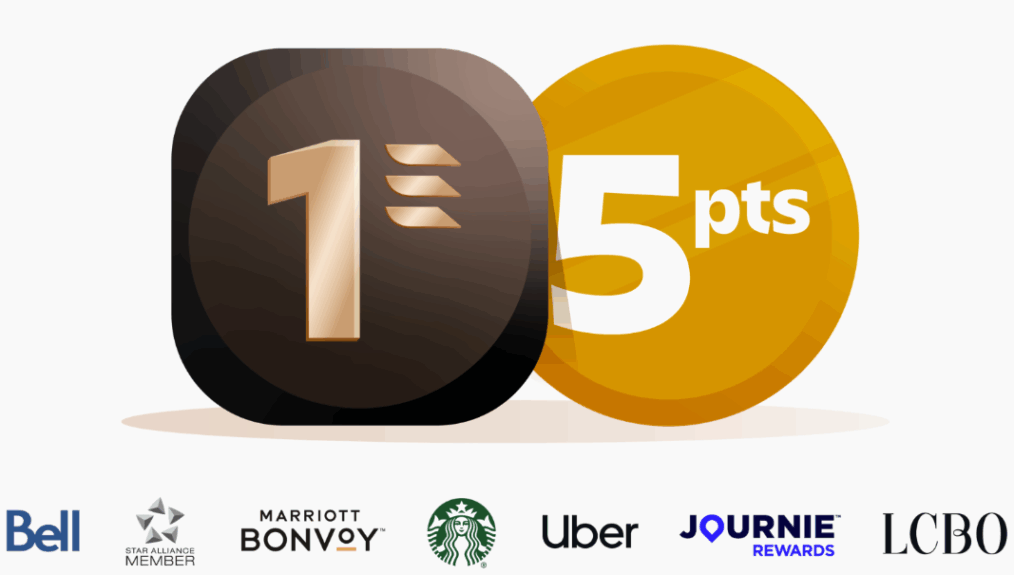
So it’s still less generous than earnings on flights, which makes sense considering they want to incentivize flying anyway.
Unfortunately, purchases on the Aeroplan eStore (which you should always use for everything you buy; one of the most basic things possible) don’t give SQC. Neither do flights on non-alliance partner airlines sold by the non-alliance partner airlines.
Note that bonus points (on top of the base rate with partners) that would be offered during promotions could be excluded from the SQC calculation. Precise details to come.
The annual cap of 25,000 SQC with this method (for all partners combined) is pretty generous.
SQC earnings on credit card spend and new card benefit
Here are the SQC earn rates on credit cards:
- Premium-level Aeroplan cards
- 1,000 SQC per 5000 CAD spent
- Business-level and Corporate-level Aeroplan cards
- 1,000 SQC per 5000 CAD spent
- Main-level Aeroplan cards
- 1,000 SQC per 20000 CAD spent
You understand why I was saying it’s not that useful for most people. There’s a lot of spending required here.
As a reminder, a premium-level Aeroplan card is a must-have if you travel on Air Canada often, including for unlimited access to Air Canada Maple Leaf VIP airport lounges for you and a guest.
| Cards | |||||||||||||||||||||||||||||||||||||||||||||||||||||||||||||||||||||||||||||||||||||||||||||||||||
|---|---|---|---|---|---|---|---|---|---|---|---|---|---|---|---|---|---|---|---|---|---|---|---|---|---|---|---|---|---|---|---|---|---|---|---|---|---|---|---|---|---|---|---|---|---|---|---|---|---|---|---|---|---|---|---|---|---|---|---|---|---|---|---|---|---|---|---|---|---|---|---|---|---|---|---|---|---|---|---|---|---|---|---|---|---|---|---|---|---|---|---|---|---|---|---|---|---|---|---|
 Valuation (BONUS) Valuation (BONUS)(≈ 5.9% back on $7.5k)
Rewards: ≈ $1041
Card fee: $599
Spend required:$7.5k in 3 mos.
Best for: For Air Canada lounge access & other AC benefits
|
|||||||||||||||||||||||||||||||||||||||||||||||||||||||||||||||||||||||||||||||||||||||||||||||||||
 Valuation (BONUS) Valuation (BONUS)(≈ 2.2% back on $24k)
Rewards: ≈ $1126
Annual fee: $599
Spend required:$24k in 12 mos.
Best for: For Air Canada lounge access and 6 passes (other lounges)
|
|||||||||||||||||||||||||||||||||||||||||||||||||||||||||||||||||||||||||||||||||||||||||||||||||||
 Valuation (BONUS) Valuation (BONUS)(≈ 2.2% back on $25k)
Rewards: ≈ $1145
Card fee:
Spend required:$25k in 12 mos. (or $15k)
Best for: For Air Canada lounge access and 6 passes (other lounges)
|
|||||||||||||||||||||||||||||||||||||||||||||||||||||||||||||||||||||||||||||||||||||||||||||||||||
| Terms and conditions apply. Flytrippers editorial opinion only. Financial institutions are not responsible for maintaining the content on this site. Please click "See More" to see most up-to-date information. |
| Cards | |||||||||||||||||||||||||||||||||||||||||||||||||||||||||||||||||||||||||||||||||||||||||||||||||||
|---|---|---|---|---|---|---|---|---|---|---|---|---|---|---|---|---|---|---|---|---|---|---|---|---|---|---|---|---|---|---|---|---|---|---|---|---|---|---|---|---|---|---|---|---|---|---|---|---|---|---|---|---|---|---|---|---|---|---|---|---|---|---|---|---|---|---|---|---|---|---|---|---|---|---|---|---|---|---|---|---|---|---|---|---|---|---|---|---|---|---|---|---|---|---|---|---|---|---|---|
 Valuation (BONUS) Valuation (BONUS)
Rewards: ≈ $1041
Card fee: $599 (≈ 5.9% back on $7.5k)
Spend required:
$7.5k in 3 mos.
Best for: For Air Canada lounge access & other AC benefits
|
|||||||||||||||||||||||||||||||||||||||||||||||||||||||||||||||||||||||||||||||||||||||||||||||||||
 Valuation (BONUS) Valuation (BONUS)
Rewards: ≈ $1126
Annual fee: $599 (≈ 2.2% back on $24k)
Spend required:
$24k in 12 mos.
Best for: For Air Canada lounge access and 6 passes (other lounges)
|
|||||||||||||||||||||||||||||||||||||||||||||||||||||||||||||||||||||||||||||||||||||||||||||||||||
 Valuation (BONUS) Valuation (BONUS)
Rewards: ≈ $1145
Card fee: (≈ 2.2% back on $25k)
Spend required:
$25k in 12 mos. (or $15k)
Best for: For Air Canada lounge access and 6 passes (other lounges)
|
|||||||||||||||||||||||||||||||||||||||||||||||||||||||||||||||||||||||||||||||||||||||||||||||||||
| Terms and conditions apply. Flytrippers editorial opinion only. Financial institutions are not responsible for maintaining the content on this site. Please click "See More" to see most up-to-date information. |
The annual cap of 25,000 SQC with this method is also pretty generous, but that implies spending 125000 CAD on the card…
However, the new annual benefit that will be added to the 4 cards starting in 2027 is amazing for those who have elite status (it is only offered to elite members). And there is no maximum SQC for that benefit, contrary to the SQC earnings with card spending.
You’ll get a headstart of 10% of SQC earned the previous year (the total SQC, not just SQC earned via the credit card). This replaces the current rollover SQM benefit.

The SQC will be automatically deposited in your Aeroplan account at the beginning of the year if you have elite status (so it doesn’t help for the 1st year if you want to reach it) and if you have the card before December 15th. We’ll remind you before this deadline!
This benefit starts in 2027, because the first year you can earn SQS is 2026. For 2026, the rollover SQM benefit will be adapted as a transitional measure. Your SQM earned in 2025 that exceed your achieved status will be converted at the rate of 5 excess SQM for 1 SQS, so it will help you qualify for the 1st year of the new system.
The small business and business cards work exactly the same way as the premium cards for SQC earnings, but don’t have the new benefit (except the Amex Aeroplan Business Reserve Card).
Don’t forget that you don’t need to have an incorporated business to get the Amex Aeroplan Business Reserve Card (nor to get any Amex “business” card; including the excellent Amex Marriott Bonvoy Business Card with a record-high offer until August 18).
Main-level Aeroplan cards are really not useful for this specific benefit, because it requires 4 times more spending. They’re convenient for free checked bags on Air Canada for you and 8 other passengers, but not so much for elite status.
| Cards | |||||||||||||||||||||||||||||||||||||||||||||||||||||||||||||||||||||||||||||||||||||||||||||||||||
|---|---|---|---|---|---|---|---|---|---|---|---|---|---|---|---|---|---|---|---|---|---|---|---|---|---|---|---|---|---|---|---|---|---|---|---|---|---|---|---|---|---|---|---|---|---|---|---|---|---|---|---|---|---|---|---|---|---|---|---|---|---|---|---|---|---|---|---|---|---|---|---|---|---|---|---|---|---|---|---|---|---|---|---|---|---|---|---|---|---|---|---|---|---|---|---|---|---|---|---|
 Valuation (BONUS) Valuation (BONUS)(≈ 14.0% back on $3k)
Rewards: ≈ $540
Card fee: $120
Spend required:$3k in 3 mos. + $1k
Best for: Valuable Aeroplan pts without min. income and lower min. spend
|
|||||||||||||||||||||||||||||||||||||||||||||||||||||||||||||||||||||||||||||||||||||||||||||||||||
 Valuation (BONUS) Valuation (BONUS)(≈ 6.0% back on $12k)
Rewards: ≈ $716
Annual fee: $0 $139
Spend required:$12k in 12 mos.
Best for: Valuable Aeroplan pts and travel benefits like free bags on AC
limited time
|
|||||||||||||||||||||||||||||||||||||||||||||||||||||||||||||||||||||||||||||||||||||||||||||||||||
 Valuation (BONUS) Valuation (BONUS)(≈ 6.6% back on $12k)
Rewards: ≈ $791
Card fee:
Spend required:$12k in 12 mos. (or $6k)
Best for: Valuable Aeroplan pts and travel benefits like free bags on AC
|
|||||||||||||||||||||||||||||||||||||||||||||||||||||||||||||||||||||||||||||||||||||||||||||||||||
| Terms and conditions apply. Flytrippers editorial opinion only. Financial institutions are not responsible for maintaining the content on this site. Please click "See More" to see most up-to-date information. |
| Cards | |||||||||||||||||||||||||||||||||||||||||||||||||||||||||||||||||||||||||||||||||||||||||||||||||||
|---|---|---|---|---|---|---|---|---|---|---|---|---|---|---|---|---|---|---|---|---|---|---|---|---|---|---|---|---|---|---|---|---|---|---|---|---|---|---|---|---|---|---|---|---|---|---|---|---|---|---|---|---|---|---|---|---|---|---|---|---|---|---|---|---|---|---|---|---|---|---|---|---|---|---|---|---|---|---|---|---|---|---|---|---|---|---|---|---|---|---|---|---|---|---|---|---|---|---|---|
 Valuation (BONUS) Valuation (BONUS)
Rewards: ≈ $540
Card fee: $120 (≈ 14.0% back on $3k)
Spend required:
$3k in 3 mos. + $1k
Best for: Valuable Aeroplan pts without min. income and lower min. spend
|
|||||||||||||||||||||||||||||||||||||||||||||||||||||||||||||||||||||||||||||||||||||||||||||||||||
|
60k/100k
 Valuation (BONUS) Valuation (BONUS)
Rewards: ≈ $716
Annual fee: $0 $139 (≈ 6.0% back on $12k)
Spend required:
$12k in 12 mos.
Best for: Valuable Aeroplan pts and travel benefits like free bags on AC
|
|||||||||||||||||||||||||||||||||||||||||||||||||||||||||||||||||||||||||||||||||||||||||||||||||||
 Valuation (BONUS) Valuation (BONUS)
Rewards: ≈ $791
Card fee: (≈ 6.6% back on $12k)
Spend required:
$12k in 12 mos. (or $6k)
Best for: Valuable Aeroplan pts and travel benefits like free bags on AC
|
|||||||||||||||||||||||||||||||||||||||||||||||||||||||||||||||||||||||||||||||||||||||||||||||||||
| Terms and conditions apply. Flytrippers editorial opinion only. Financial institutions are not responsible for maintaining the content on this site. Please click "See More" to see most up-to-date information. |
So if you want to qualify for elite status with your spending, get a premium Aeroplan card. You’ll get another huge welcome bonus too!
For those who want to use our upcoming trick to get much more generous American credit cards, the Aeroplan card issued in the United States continues to offer 25K elite status automatically after spending 15000 USD, but there are other changes that I’ll explain separately.
No changes to 3 other features
I want to highlight a few elements that aren’t changing, to the great pleasure of many.
The Everyday Status Qualifying (EDQ) remains unchanged. In fact, it doesn’t change in theory: you’ll get 25K elite status without setting foot on a plane if you earn 100,000 Aeroplan points in the year (excluding welcome bonuses and Amex point transfers).
That said, in practice, some benefits currently obtained with 25K status will become milestone rewards (change #3 below), and therefore 25K statuts obtained through EDQ will no longer give access to them.
Hats off to Aeroplan for at least keeping this option; it would have been easy to say the new system replaces it because it allows qualifying without flying as well. But they committed to keeping this when they bought back the independent Aeroplan program, and they continue to honor that. That’s rare to see, too!
The new SQC system already makes it possible to qualify separately without flying, but doesn’t include points earned via the Aeroplan eStore. Those continue to be included in the EDQ.
Lifetime Million Mile status continues to be calculated based on distance flown on Air Canada flights. They consider it sacred and symbolic, to reward the most loyal of the loyals.
The Banked Super Elite status benefit doesn’t change. It will be one of the choices offered at 200,000 SQC instead of 250,000 SQM.
Aeroplan change 3: Elite status benefits
These are the least significant changes that affect some of the elite status benefits. Specifically, a bunch of separate benefits are being replaced by new, simpler milestone rewards.
Here are the basics of Aeroplan changes for elite status benefits:
- Introduction of milestone rewards
- Unlocked at each SQC milestone
- Offered every 10,000 SQC
- Up to 200,000 SQC
- Then every 20,000 SQC up to 1,000,000 SQC
- Then it stops there, but you won’t get there 😅
- Requires already having elite status
- So it makes the 1st year less interesting
- And incentivizes keeping status when you have it (also logical)
- 2 different types depending on the milestone
- Some are a fixed automatic benefit
- Some are a choice to make between different benefits
- Includes several benefits
- Priority rewards
- Bonus points
- Discounts on points redemptions
- Status passes to offer
- And much more
- Replaces several current benefits
- Select benefits
- Priority rewards
- Threshold eUpgrades
- Threshold gifts
- Delays getting eUpgrades
- Fewer automatically deposited at the beginning
- Become milestone rewards
- Other benefits don’t change
- Like free lounge access (50K status and above)
- And all others
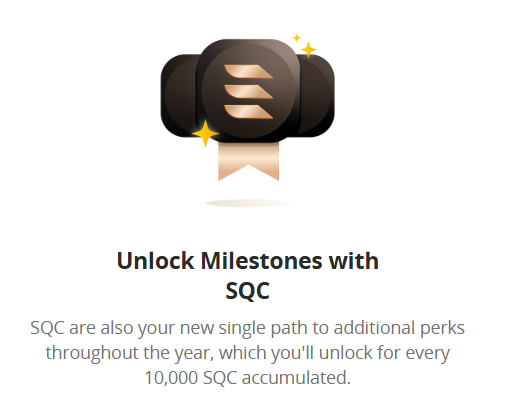
Analysis of the Aeroplan elite status benefits changes
Milestone benefits aim to give benefits more frequently, or rather more constantly, I’d say.
Different benefits will be offered at every 10,000 SQC for almost all elite members. If you exceed 200,000 SQC, then benefits will be offered at every 20,000 SQC. It stops completely at the 1,000,000 SQC threshold, but you don’t need to worry about that; let’s be real.
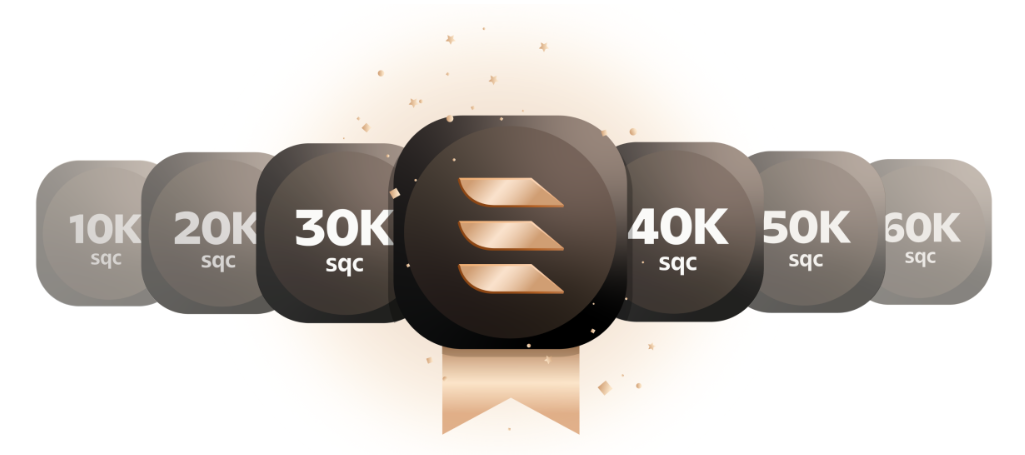
Warning: you must already have the status to get the benefits. So a traveler who has no status won’t have milestone benefits at 10,000 SQC and 20,000 SQC! After reaching 25,000 SQC for 25K elite status, then it starts. So the 1st year is a bit less lucrative, to reward travelers with a status and incentivize always keeping your status.
It’s true that this aspect was complex. There were the select benefits, the priority rewards, and the threshold benefits that were all a bit separate. It was very fragmented. All that will be more cohesive under milestone rewards.
Other elite status benefits don’t change at all.
I will stop here because this guide already is quite colossal. I will do a separate post about the elite status benefits to help you soon. You can check out the complete list of milestone rewards in the meantime.
Learning how to travel for less
Join over 100,000 savvy Canadian travelers who already receive Flytrippers’ free newsletter so we can help you travel for less — including thanks to the wonderful world of travel rewards!
Sign up for our travel rewards newsletter
Sign up for our newsletter
Summary
The Aeroplan changes are by far the most significant since the program’s complete overhaul in 2020. Points earning and elite status qualification instrument earning switch to revenue-based mode, meaning based on the amount spent rather than on distance, as is currently the case. And there are changes to elite status benefits that are somewhat less significant.
What would you like to know about the Aeroplan changes? Tell us in the comments below.
See the flight deals we spot: Cheap flights
Discover free travel with rewards: Travel rewards
Explore awesome destinations: Travel inspiration
Learn pro tricks: Travel tips
Featured image: Palih Boraca, Bosnia and Herzegovina (photo credit: Luka Korica, edited by Flytrippers)


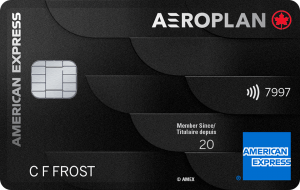
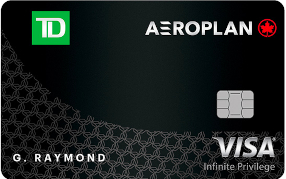

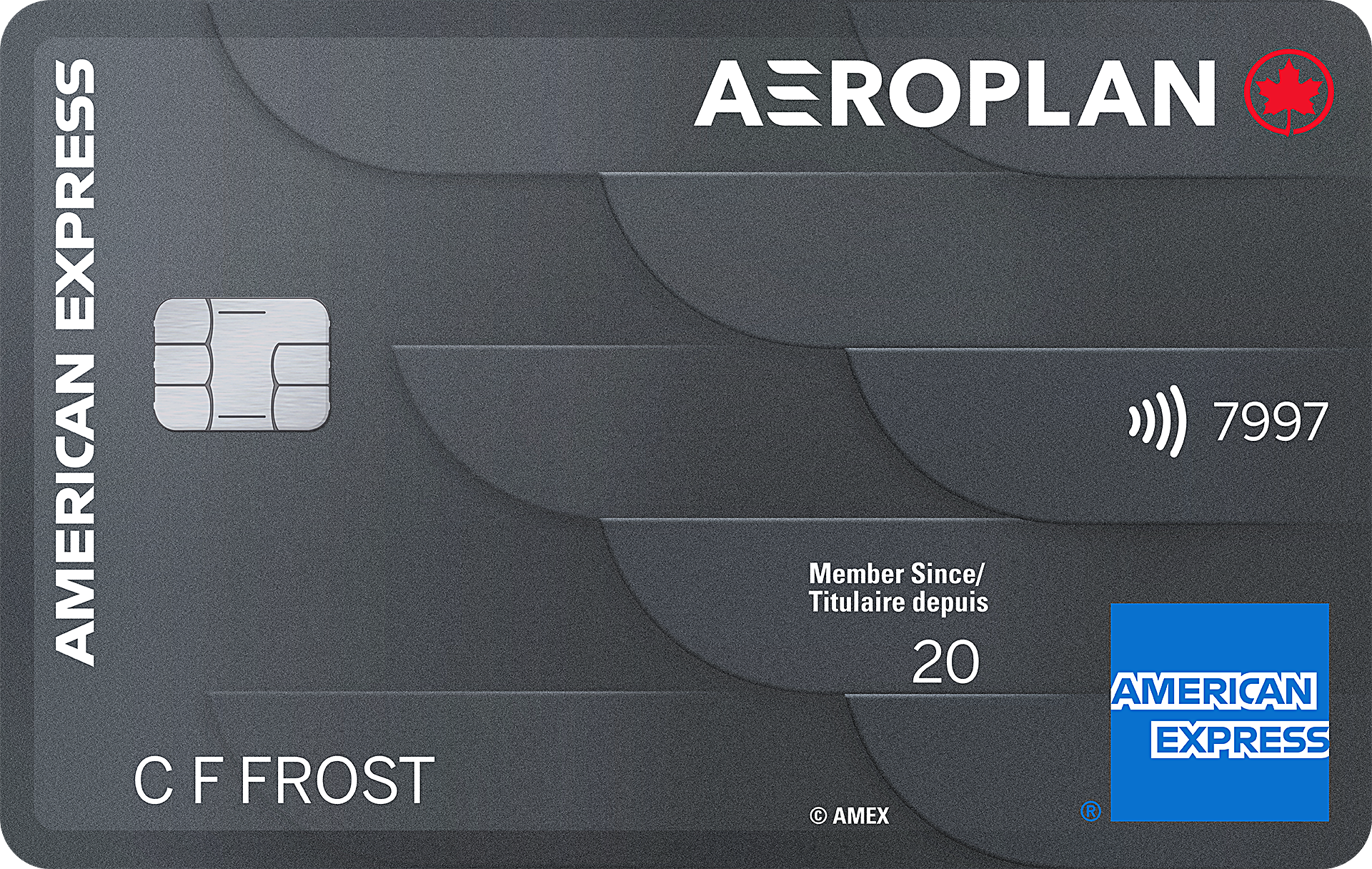
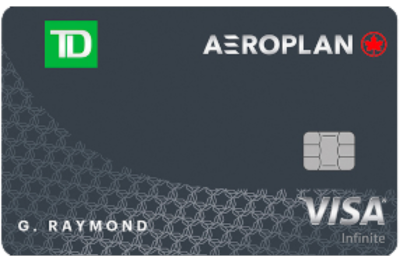




This seems to be a very optimist view on how these changes will affect travellers. I’m surprised to hear that Air Canada thinks most people will get the same or higher status, when all the discussions online are people figuring out it will mean fewer points and lower status. This is a serious downgrade for many frequent fliers. The only people who are better off are people who spend a lot of money on business class tickets
Hi, I would imagine it’s kind of like reading airline review: everyone who’s had a bad experience will definitely go write a review, but the vast majority who have had a regular experience won’t.
Definitely unfortunate for those who will end up with a lower status, but since they’re a publicly-listed company, I believe them if they say the data shows a majority will retain the same level based on the data.